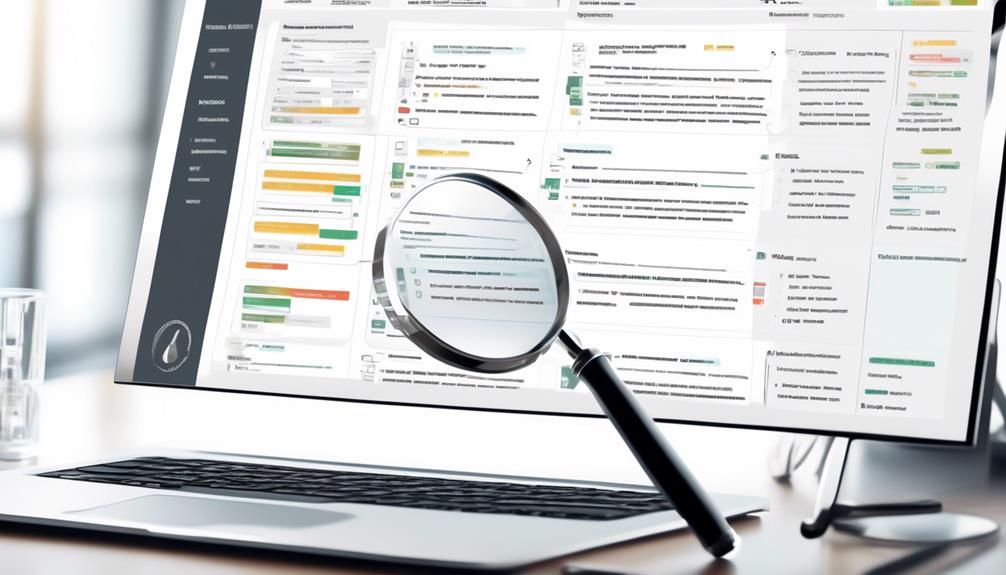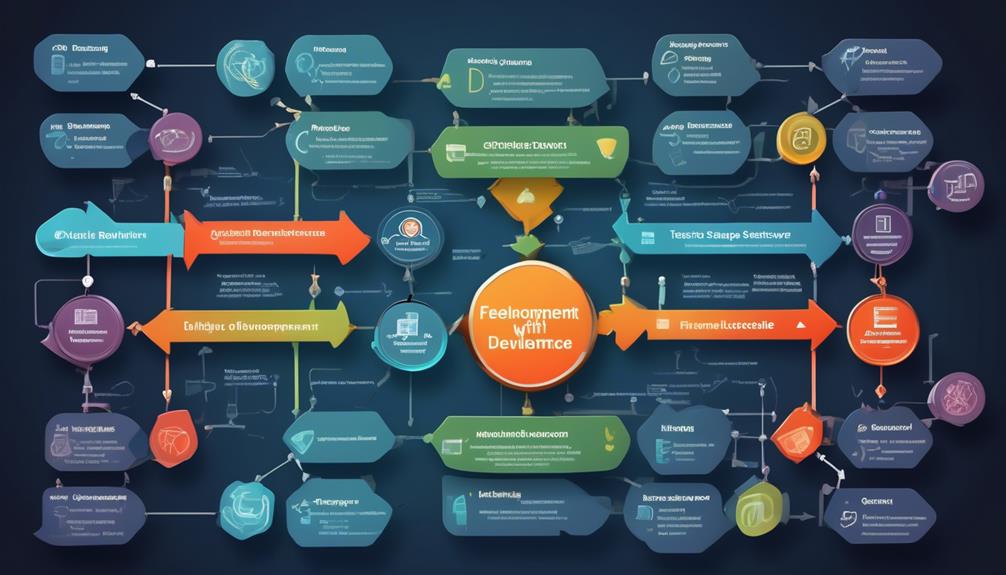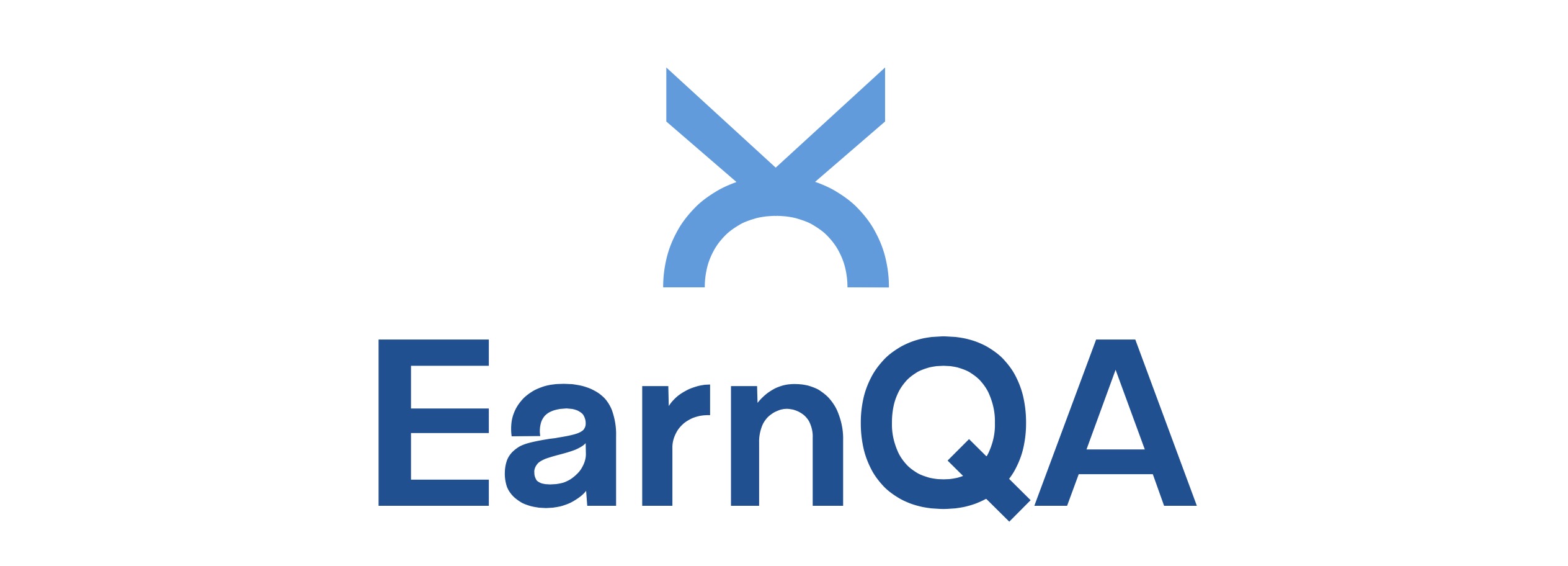SQA Best Practices
Never Stop Improving: Top Industry Secrets for Continuous Excellence in Software Quality Assurance!
Improve your SQA process with these best practices for continuous improvement. Learn how to enhance your software quality assurance efforts and deliver better products to your customers.

It’s widely known that 68% of software projects fail to meet their goals concerning quality, budget, or schedule. Therefore, what approaches can we adopt to ensure our software quality assurance (SQA) techniques are continuously improving, to avoid falling into that statistic?
In this discussion, we’ll explore best practices for continuous improvement in SQA and how they can help us not only meet but exceed quality standards.
From strategies for enhancing processes to tools for measurement and team collaboration best practices, we’ll uncover practical insights that can elevate our SQA efforts to new heights.
Key Takeaways
- Continuous improvement in SQA enhances adaptability and effectiveness of QA practices.
- Implementing automation and investing in QA tools can lead to higher efficiency and accuracy in software testing.
- Foster a culture of collaboration and knowledge sharing within the testing team.
- Focus on improving customer satisfaction through high-quality software by implementing a culture of improvement.
Importance of Continuous Improvement
Continuous improvement in software quality assurance and testing plays a vital role in ensuring the adaptability and effectiveness of these practices within the ever-evolving technological landscape. The continuous improvement process is integral to the enhancement of QA and testing.
It not only leads to better testing practices but also results in higher software quality and increased customer satisfaction. Furthermore, it fosters innovation by encouraging the exploration and implementation of new approaches and tools, ultimately leading to more efficient and streamlined processes.
This improvement in software testing is crucial in ensuring that QA practices adapt, thrive, and deliver excellence in technology. It also plays an essential role in the quality management plan, ensuring that quality control is maintained throughout the software development process.
Moreover, continuous improvement in software testing is closely linked to test automation, as it provides the foundation for automating repetitive tasks and achieving higher levels of efficiency and accuracy. Therefore, the importance of continuous improvement in QA and testing can’t be overstated, as it’s fundamental to the overall success and quality of software development.
Strategies for Enhancing Processes

As we consider strategies for enhancing processes in software quality assurance and testing, it becomes imperative to embrace the principles of continuous improvement that underpin the adaptability and effectiveness of these practices within the ever-evolving technological landscape.
Embracing the Kaizen philosophy for small, incremental improvements in the software testing process is essential. Implementing automation for repetitive and time-consuming tasks enhances efficiency in testing, allowing for more focus on complex and critical areas.
Furthermore, fostering a culture of peer reviews and knowledge sharing can provide fresh perspectives and improve testing practices. Regular retrospectives are also vital to evaluating and driving continuous improvement in the software testing process.
Investing in training and skill development for QA professionals ensures ongoing improvement and excellence in testing practices. It’s also crucial to emphasize clear communication between teams, effective quality management, and the development of comprehensive test plans.
Tools for Continuous Improvement
We meticulously assess various tools and technologies for test process improvement in software quality assurance, emphasizing their role in enhancing the effectiveness and adaptability of our practices.
When evaluating tools for continuous improvement in SQA, we consider the following:
- Automated Testing and Scenario Analysis:
Utilizing automated testing tools to streamline the testing process and scenario analysis for identifying potential issues in software products.
- Quality Management and Communication Between Teams:
Implementing tools for establishing quality criteria, control activities, and facilitating communication between teams to ensure a collaborative approach to development process.
In addition to these considerations, it’s crucial to measure the success of test process improvement. Monitoring and measuring quality performance, using the PDCA approach, and fostering a culture of continuous improvement are integral to our best practices.
Moreover, investing in the right QA tools, test data identification, and skill development of the testing team are essential for achieving continuous improvement in SQA. Tools such as test management tools, test automation tools, continuous integration and delivery tools, performance testing tools, and defect tracking and management tools play a vital role in the enhancement of our testing processes.
Team Collaboration Best Practices

To enhance team collaboration best practices, fostering a culture of knowledge sharing and collaboration among the testing team is imperative. Within the software development life cycle, effective communication and collaboration are essential for successful quality management.
It’s crucial to implement a comprehensive test strategy and plan to align the team’s efforts and objectives. This ensures that everyone is working towards a common goal, promoting a collaborative environment.
Regularly evaluating and measuring the effectiveness of team collaboration initiatives is vital for continuous improvement. This process allows for the identification of areas that require improvement and the implementation of targeted solutions.
Additionally, investing in training and skill development of the testing team enhances their collaboration and communication skills, further strengthening the team’s collaborative capabilities.
Implementing peer reviews, knowledge sharing sessions, and retrospectives are also effective methods to drive continuous improvement in team collaboration. These practices not only support the continuous improvement of QA processes but also foster a culture of collaboration and knowledge sharing within the testing team.
Cultivating a Culture of Improvement
Cultivating a culture of improvement within an organization requires a dedicated focus on fostering collaboration, communication, and feedback to continuously enhance software development practices. To achieve this, we need to focus on the following:
- Active Product Development Cycle
Implement an active product development cycle that integrates QA into every stage, ensuring that quality management and testing are integral parts of the process.
Foster frequent communication between teams to facilitate rapid adjustments and improvements, resulting in a more agile and responsive development environment.
- Methods to Improve Customer Satisfaction
Establish robust feedback loops involving stakeholders to drive improvements and ensure that software solutions meet evolving customer needs and expectations.
Invest in training and skill development for QA professionals to equip them to drive and implement improvement strategies, ultimately leading to the production of high-quality software that consistently meets customer satisfaction.
Frequently Asked Questions
What Is Continuous Improvement in Qa?
Continuous improvement in QA involves an ongoing process of evaluating and enhancing the software development process, tools, and methodologies. It helps businesses ensure the quality of their products, reduce expenses, and increase productivity.
What Are the 4 Stages of Continuous Improvement?
We identify the 4 stages of continuous improvement as Plan, Do, Check, and Act.
In the Plan stage, we set objectives and develop a test plan.
During the Do stage, we carry out testing processes and analyze outcomes.
In the Check stage, we review results and identify flaws.
What Are the Effective Methods to Ensure the Success of Sqa?
We ensure SQA success through rigorous testing, continuous process improvement, and stakeholder collaboration.
Our approach involves thorough test planning, efficient defect management, and automated testing.
We prioritize post-project and in-process escape analysis to guide improvement efforts.
By implementing efficient QA standards, we reduce waste and inefficiencies, ensuring high-quality software.
Our focus on continuous improvement allows us to adapt to evolving requirements and maintain a high standard of quality in our software products.
What Is the Improvement Plan for Qa?
We propose a proactive approach to our QA improvement plan, prioritizing precision, process, and performance.
Our strategy involves evaluating existing procedures, implementing automated testing tools, and setting clear quality goals.
By embracing the Kaizen philosophy, we drive continuous improvement through small, incremental changes.
This meticulous approach ensures that our QA efforts are constantly evolving and optimizing, leading to enhanced software development processes and high-quality end products.
Conclusion
In conclusion, continuous improvement in SQA is essential for staying ahead in the competitive software industry.
By embracing this mindset, we can pave the way for innovation, efficiency, and excellence in our processes.
Like a skilled craftsman honing their masterpiece, we must constantly refine and perfect our methods to create software that exceeds expectations and stands the test of time.
At the helm of our content team is Amelia, our esteemed Editor-in-Chief. Her extensive background in technical writing is matched by her deep-seated passion for technology. Amelia has a remarkable ability to distill complex technical concepts into content that is not only clear and engaging but also easily accessible to a wide range of audiences. Her commitment to maintaining high-quality standards and her keen understanding of what our audience seeks are what make her an invaluable leader at EarnQA. Under Amelia’s stewardship, our content does more than just educate; it inspires and sets new benchmarks in the realm of QA education.
SQA Best Practices
Unlock the Secrets of Software Quality Assurance: Best Practices and Benefits
Software Quality Assurance ensures that the software meets the highest standards. It involves testing, bug identification, and ensuring the software performs as expected.

Everyone knows those pesky software bugs bite us hard, chewing through a whopping **$1.1 trillion** globally each year. But let’s chat about Software Quality Assurance (SQA) for a sec. What’s the deal with it, really?
Well, it's not just about finding and fixing bugs. SQA encompasses a comprehensive approach to ensuring that the software meets quality standards at every stage of its development.
But what exactly does this process entail, and why is it so crucial in today's tech-driven world?
Join me as we explore the intricacies of SQA and unravel its significance in delivering reliable, high-quality software solutions.
Key Takeaways
- Software Quality Assurance (SQA) ensures software meets quality standards at every stage of its life cycle
- SQA goes beyond error identification and includes creating an SQA plan
- SQA aims to prevent defects from occurring and reduces the risk of errors and defects
- SQA upholds quality standards, saves time and costs, and enhances software stability and competitiveness
Definition of Software Quality Assurance
In software development, the term 'Software Quality Assurance' refers to the meticulous process of ensuring that the software meets predetermined quality standards at every stage of its life cycle. Software Quality Assurance (SQA) is an integral part of the software development process, working in parallel to ensure that the product meets established quality specifications. It involves a comprehensive approach to quality, aiming to catch and rectify any potential shortcomings before the software is released to the public.
SQA goes beyond mere error identification, encompassing a broad range of quality aspects. It includes creating an SQA plan, setting checkpoints for regular quality inspections, deploying software engineering techniques to ensure high-quality specifications, conducting formal technical reviews, and utilizing a multi-testing strategy. The primary goal of SQA isn't only to detect defects but also to prevent them from occurring in the first place.
Moreover, SQA extends its focus beyond software testing to ensure the software's portability, usability, reusability, correctness, and maintainability. This detailed approach to quality assurance is vital in the software development process, as it ultimately impacts the reliability and success of the final product.
Key Components of Software Quality Assurance

Key components of Software Quality Assurance encompass:
- Applying a comprehensive quality management approach to ensure adherence to established standards throughout the software development process.
- Formal technical reviews play a crucial role in evaluating the design and quality of the software, identifying and addressing any issues that may arise.
- A multi-testing strategy is essential, utilizing various testing approaches to comprehensively test the software and ensure its quality.
- Effective software engineering technology is a critical component, employing advanced techniques to achieve high-quality specifications and meet standards for software quality attributes.
- The implementation of a robust measurement and reporting mechanism is vital, providing a means to track and report on the quality of the software throughout the development process.
Each of these components plays a significant role in the Software Quality Assurance Plan, ensuring that quality is a fundamental aspect of all software development processes, activities, and management within a project. This ultimately leads to high-quality software products.
Importance of Software Quality Assurance
Building on the foundation of key components in Software Quality Assurance, the importance of SQA in ensuring high-quality software products can't be overstated. SQA plays a pivotal role in upholding quality standards and ensuring that software meets customer expectations. By implementing rigorous software testing and a defect management approach, SQA significantly reduces the risk of errors and defects, ultimately saving time and costs while enhancing the stability and competitiveness of the software product.
Throughout the Development Life Cycle (SDLC), SQA is crucial for maintaining quality management, continuously monitoring, and improving the software. It not only enhances the efficiency and reliability of the software but also contributes to its maintainability, usability, and portability. Moreover, SQA is essential for safeguarding the reputation and credibility of a business, as it ensures security, compliance, and customer satisfaction.
The responsibilities of SQA encompass various critical aspects, including adherence to quality standards, comprehensive testing, and effective defect management. By fulfilling these responsibilities, SQA significantly contributes to the overall success of software development, thereby emphasizing its indispensable importance in the software industry.
Implementation of Software Quality Assurance

Implementing Software Quality Assurance requires a meticulous approach to ensure that established quality specifications are consistently met throughout the software development life cycle. It involves setting up standards and procedures for quality assurance and quality control.
This implementation process requires careful planning, as it encompasses various activities such as formal technical reviews, multi-testing strategies, and the use of advanced software engineering techniques. The implementation of SQA also involves creating an SQA plan that outlines the checkpoints for regular quality inspection and identifies the responsibilities of each team member in maintaining quality standards.
Additionally, it requires a systematic approach to integrate quality assurance and quality control into the daily work of software development. This includes utilizing tools and methodologies that enable continuous monitoring and improvement of the software quality.
Difference Between Quality Assurance and Testing
Quality assurance and testing serve distinct purposes in the software development process, each with its own specific focus and objectives.
Quality assurance (QA) primarily concentrates on ensuring that software meets established quality specifications, encompassing ongoing processes that run parallel to software development to check for quality issues in each phase. It aims to catch product shortcomings before the public sees them, covering activities like creating an SQA plan, setting checkpoints for regular quality inspection, and conducting formal technical reviews to evaluate design and quality.
On the other hand, testing is a specific phase focused on identifying and reporting bugs. Its primary goal is to find errors, and it may or may not involve addressing and solving identified errors. While QA encompasses a multi-testing strategy for comprehensive testing, testing itself is focused on finding errors in the software.
Frequently Asked Questions
What Does Software Quality Assurance Consist Of?
Software Quality Assurance consists of several key components.
First, there is the creation of a plan, which outlines the overall approach to quality assurance for a software project. This plan may include details on inspection checkpoints, engineering techniques, and formal reviews that will be used throughout the development process.
The second component is the implementation of this plan. This involves carrying out the inspection checkpoints, deploying the engineering techniques, conducting the formal reviews, and ensuring that all steps are followed according to the plan.
The third component is the multi-testing strategy. This strategy involves testing the software from various angles and perspectives to ensure that it meets the required quality standards.
SQA also covers various aspects of software quality, including portability, usability, reusability, correctness, and maintainability. These factors are important in ensuring that the software is not only functional but also reliable and easy to use.
Overall, SQA aims to catch any shortcomings in the software before it is released to the public. By resolving errors and ensuring that the software meets the necessary quality standards, SQA helps to improve the overall user experience and satisfaction.
To achieve these goals, a quality management approach is necessary. This approach ensures that all aspects of SQA are properly managed and executed. It also includes formal technical reviews, which provide a structured and systematic way to assess the software's quality.
In addition, effective software engineering technology is key to successful SQA. This technology includes tools and techniques that aid in the development, testing, and evaluation of software products.
Measurement and reporting mechanisms are also important components of SQA. These mechanisms allow for the monitoring and tracking of the software's quality throughout the development process. They provide valuable insights into the effectiveness of the SQA efforts and help to identify areas for improvement.
What Is the Role of a Quality Assurance Software?
The role of Quality Assurance Software is to ensure the software meets established quality specifications throughout the development process.
It works parallel to software development, checking for quality issues in each phase and aims to catch product shortcomings before public release.
Our team creates an SQA plan, sets checkpoints for regular quality inspection, deploys software engineering techniques, conducts formal technical reviews, and employs a multi-testing strategy to uphold quality standards.
What Do You Mean by Quality Assurance?
Quality assurance ensures that products meet established quality standards throughout the development process. It goes beyond simple error detection, aiming to solve issues and prevent them from reaching the public.
An interesting statistic is that SQA can reduce production costs by up to 50% and prevent up to 90% of potential issues.
This meticulous process involves creating a solid SQA plan, regular quality inspections, and comprehensive testing to ensure high-quality software that meets client expectations.
What Is an Example of Quality Assurance in Software?
An example of quality assurance in software is ensuring the usability, portability, correctness, maintainability, and reusability of the software product.
We achieve this by:
- Creating an SQA plan
- Setting checkpoints for regular quality inspection
- Deploying software engineering techniques
- Conducting formal technical reviews
- Utilizing a multi-testing strategy
Our approach involves:
- Auditing
- Reviewing
- Code inspection
- Design inspection
- Simulation
These techniques are used to ensure software quality.
Conclusion
In the world of software development, Software Quality Assurance is like the meticulous gardener who carefully tends to each plant, ensuring that they grow strong and vibrant.
It involves constant monitoring, inspection, and problem-solving to ensure that the final product meets the highest quality standards.
Just as a master chef carefully tastes and adjusts their dish, SQA ensures that software is flawless and ready to delight its users.
Rick, our Software Quality Assurance Writer, is the creative force behind many of our insightful articles and course materials. His unique background in software development, fused with his natural flair for writing, allows him to convey complex QA concepts in a way that is both informative and captivating. Rick is committed to keeping abreast of the latest trends and advancements in software testing, ensuring that our content remains not just relevant, but at the forefront of the field. His significant contributions are instrumental in helping us fulfill our mission to deliver premier QA education.
SQA Best Practices
Software Quality Assurance Audit Process Insights

Welcome to our discussion regarding the software quality assurance audit process. In the swiftly changing digital scene, the quality of software stands as a critical factor for the success of any organization. Carrying out a software quality audit is crucial in ensuring that both software products and their creation methods meet industry standards, adhere to best practices, and are free of vulnerabilities that could compromise the software’s reliability.
Key Takeaways:
- A software quality audit evaluates software products and development processes to identify areas of improvement and ensure compliance with industry standards.
- Software Quality Assurance (SQA) focuses on preventing defects and maintaining desired quality standards throughout the software development lifecycle.
- Software audits involve an independent examination of software artifacts and practices to assess compliance and identify areas for improvement.
- A successful software quality audit requires clear objectives, thorough assessments, and implementation of necessary changes.
- Audit testing is crucial for evaluating software performance, ensuring compliance, and maintaining high-quality standards.
What is a Software Quality Audit?
In the world of software development, ensuring the delivery of high-quality products and services is paramount. This is where a software quality audit comes into play. A software quality audit is a comprehensive evaluation process that examines various aspects of software development to assess its adherence to quality standards, industry best practices, and organizational requirements.
A software quality audit encompasses elements of both Software Quality Assurance (SQA) and Software Audits. It goes beyond simply evaluating software functionality and delves deeper into the software development processes themselves. By conducting a thorough assessment, organizations gain valuable insights into the effectiveness and efficiency of their software development practices.
During a software quality audit, the entire software development lifecycle is scrutinized, including project planning, requirements management, coding, testing, and deployment. All aspects of the development process are thoroughly evaluated to identify any potential gaps or deficiencies.
A software quality audit is not just about finding bugs or defects in the software; it is about enhancing the overall quality of the software development processes.
By conducting an audit, organizations can ensure that their software development practices align with industry standards and best practices. This helps improve the overall quality of the software being developed and reduces the risk of critical issues occurring in the future.
Furthermore, a software quality audit provides organizations with a roadmap for continuous improvement. It offers valuable insights and recommendations for refining and optimizing the development processes, leading to increased efficiency and better outcomes.
Let’s take a closer look at the key components and scope of a software quality audit in the next section.
Software Quality Assurance (SQA)
In the realm of software development, ensuring a proactive approach towards quality is imperative. That’s where Software Quality Assurance (SQA) comes in. SQA is a systematic and proactive approach to preventing defects and ensuring that software meets the desired quality standards.
At every stage of the software development lifecycle, SQA plays a critical role. By implementing rigorous tasks and processes, SQA helps identify and address potential quality issues, ensuring that the end product meets both the organization’s internal standards and industry-wide quality benchmarks.
SQA encompasses a comprehensive range of activities such as:
- Requirements analysis and validation
- Design and code reviews
- Testing and test management
- Quality measurement and monitoring
- Defect prevention and control
The proactive nature of SQA sets it apart from other quality assurance approaches. Rather than just detecting and fixing defects after they occur, SQA actively seeks to prevent defects from happening in the first place. This proactive stance helps streamline the software development process, saving both time and resources.
By adhering to established quality standards and continually evaluating and refining the SQA process, organizations can ensure that their software products are reliable, secure, and perform optimally.

The image above visually represents the essence of Software Quality Assurance — the proactive approach to ensuring software quality throughout the development lifecycle.
SQA acts as a key gatekeeper, ensuring that software goes through a rigorous quality assurance process before it reaches end-users. This helps build trust and confidence in the software and establishes a solid foundation for success.
| Benefits of Software Quality Assurance | Objectives of Software Quality Assurance |
|---|---|
|
|
As demonstrated in the table, SQA brings multiple benefits to software development projects. By achieving its objectives, SQA assists organizations in delivering high-quality software that meets both the expectations of end-users and the demands of the competitive marketplace.
Software Audits
Software audits play a crucial role in ensuring the quality and compliance of software projects, processes, and products. Through retrospective assessments and independent examination, software audits help identify areas of improvement, verify compliance, and ensure adherence to best practices.
The Importance of Software Audits
Retrospective assessments provide valuable insights into the effectiveness of software development practices and strategies. By conducting independent examinations of software artifacts, documentation, and development practices, audits help organizations:
- Identify areas of improvement
- Verify compliance with industry standards
- Ensure adherence to best practices
Software audits are a vital part of quality assurance and compliance verification, enabling organizations to optimize their software development processes and enhance overall performance.
Components of a Software Audit
A comprehensive software audit typically includes the following components:
- Documentation review: Assessing the accuracy, completeness, and organization of software documentation.
- Code review: Examining the source code for quality, readability, and adherence to coding standards.
- Process review: Evaluating the software development processes to identify bottlenecks and inefficiencies.
- Security assessment: Analyzing the software’s security measures to identify vulnerabilities and potential risks.
- Compliance assessment: Ensuring the software complies with relevant laws, regulations, and industry standards.
By examining these key areas, software audits provide a holistic evaluation of the software’s quality and compliance.
Benefits of Software Audits
Software audits offer a range of benefits to organizations:
“Software audits provide valuable insights into the software’s quality and compliance, helping organizations identify and rectify deficiencies, improve overall performance, and mitigate risks.”
These assessments enable organizations to enhance their software development processes, optimize resource allocation, and ensure that their software meets the highest quality standards.

| Benefits of Software Audits | Description |
|---|---|
| Identification of deficiencies | Software audits help identify weaknesses and areas for improvement, allowing organizations to rectify them and enhance overall quality. |
| Assurance of compliance | Through compliance verification, software audits ensure that organizations meet regulatory and industry standards. |
| Risk mitigation | By identifying vulnerabilities and potential risks, software audits enable organizations to implement measures to mitigate those risks. |
| Process optimization | Software audits help optimize software development processes, enhancing efficiency and resource utilization. |
Key Components and Scope of a Software Quality Audit
In a software quality audit, several key components and activities are crucial for assessing and improving software quality. These components include:
- Planning: Establishing clear objectives, scope, and timelines for the audit.
- Documentation Review: Assessing the completeness, accuracy, and compliance of software-related documents such as requirements, design specifications, and test plans.
- Code Review: Evaluating the quality, readability, maintainability, and adherence to coding standards of the software’s source code.
- Process Review: Analyzing the software development and quality assurance processes to identify any inefficiencies or areas for improvement.
- Security Assessment: Assessing the software’s vulnerability to security threats and ensuring the implementation of appropriate security measures.
- Compliance Assessment: Verifying that the software conforms to industry standards, regulations, and relevant legal requirements.
By conducting these activities, a software quality audit provides a comprehensive assessment of various aspects of software development. It helps organizations identify weaknesses, improve processes, reduce risks, and ensure compliance with standards and regulations.
To illustrate the components and scope of a software quality audit, here is a sample table showcasing the different activities and their objectives:
Benefits of Software Quality Audits
Software quality audits offer numerous benefits that contribute to the improvement of software development processes, compliance, risk mitigation, and overall software quality. Through these audits, we can identify and remediate deficiencies, ensure compliance with industry standards, mitigate potential risks, and optimize our processes.
Identification and Remediation of Deficiencies: Software quality audits help us detect any shortcomings or weaknesses in our software products or development processes. By conducting a thorough evaluation, we can identify areas that require improvement and take appropriate measures to address them effectively.
Assurance of Compliance: Compliance with industry standards and regulations is of utmost importance for any software development organization. Software quality audits enable us to assess our compliance status, ensuring that our products meet the necessary criteria and adhere to established standards.
Risk Mitigation: Audits play a crucial role in identifying potential risks that may compromise the integrity or functionality of our software. By proactively identifying these risks, we can implement appropriate measures to mitigate them, safeguarding our software and protecting our stakeholders.
Process Optimization: Through software quality audits, we gain valuable insights into our development processes. We can identify areas where optimization is required and implement changes that enhance efficiency, productivity, and overall performance.
To illustrate the benefits of software quality audits, consider the following table:
Benefits Description Identification and Remediation of Deficiencies Identify and address weaknesses in software products and development processes. Assurance of Compliance Ensure adherence to industry standards and regulations. Risk Mitigation Identify and mitigate potential risks that may impact software integrity. Process Optimization Optimize software development processes for enhanced efficiency and productivity.

By leveraging the benefits of software quality audits, organizations can elevate their development standards, improve software quality, and ensure the delivery of reliable and high-performing software products.
Best Practices for Successful Software Quality Audits
To ensure the effectiveness and success of software quality audits, we recommend following these best practices:
- Establish Clear Objectives and Criteria: Clearly define the objectives and criteria for the audit. This will ensure that the assessment focuses on specific areas of concern and enables you to measure the software’s compliance with quality standards.
- Conduct a Thorough Assessment: In order to identify areas for improvement, thoroughly assess all aspects of the software development process, including documentation, code, testing, and security measures. Use a comprehensive approach to uncover any deficiencies and vulnerabilities.
- Implement Necessary Changes: Once deficiencies are identified, it is crucial to take action. Implement necessary changes to address the identified issues and improve the overall quality of the software. This could involve redesigning processes, refining documentation, enhancing security measures, or optimizing the code.
By following these best practices, you can establish a solid foundation for the audit process, ensure clear objectives and criteria, conduct a thorough assessment, and implement the necessary changes to enhance software quality.

Why is Audit Testing Important?
Audit testing is essential for several reasons:
- Compliance with defined standards: Audit testing verifies that the software follows industry standards and guidelines, ensuring that it meets the expected quality benchmarks.
- User satisfaction: By conducting thorough audit testing, we can identify and address any issues or shortcomings in the software that may affect the user experience. This, in turn, leads to improved user satisfaction.
- Ensuring software quality: Audit testing acts as a quality control mechanism, enabling us to detect and rectify any potential flaws or errors in the software before it is released to the end-users.
Types of Audit Testing
There are different types of audit testing, each serving a specific purpose:
Audit Testing Type Description Inquiry Obtaining information from relevant stakeholders through structured interviews or questionnaires. Observation Directly observing the software development and quality assurance processes to evaluate their effectiveness and adherence to standards. Examination Reviewing documentation, code, and artifacts to assess compliance and identify any deviations from best practices. Re-performance Repeating specific steps or actions within the software to ensure their accuracy and effectiveness. Computer-Assisted Audit Technique (CAAT) Using specialized software tools to automate audit procedures and analyze large volumes of data efficiently.
By employing these different types of audit testing, we can thoroughly evaluate the software’s development and quality assurance processes and identify areas that require improvement.
Overall, audit testing serves as a vital component of software quality assurance, enabling businesses to ensure compliance with defined standards, enhance user satisfaction, and deliver high-quality software products.
Importance of Audit Testing in Software Quality Assurance
Audit testing plays a crucial role in ensuring software quality assurance. By conducting comprehensive assessments, businesses can evaluate their compliance with industry standards, enhance user satisfaction, and maintain high software quality. This section explores the importance of audit testing in software quality assurance and its impact on overall software development.
The Benefits of Compliance with Standards
Compliance with standards is paramount in software development. Audit testing ensures that software products and processes adhere to industry standards, regulatory requirements, and best practices. It helps businesses identify any deviations from these standards and rectify them promptly. By maintaining compliance, businesses can build trust with their customers, partners, and stakeholders, while mitigating legal and reputational risks.
Enhancing User Satisfaction
User satisfaction is a critical measure of software success. Through audit testing, businesses can assess their software’s functionality, usability, and performance from the end-users’ perspective. By identifying and rectifying any shortcomings or issues, businesses can deliver software that meets user expectations and ensures a positive user experience. This, in turn, fosters customer loyalty and enhances the software’s reputation.
Maintaining High Software Quality
Audit testing serves as a proactive approach to maintaining high software quality. It helps businesses identify weaknesses or vulnerabilities in their quality assurance processes and implement necessary improvements. By conducting regular audits, businesses can optimize their software development practices, improve code quality, enhance testing procedures, and minimize the occurrence of bugs or defects. This, in turn, leads to higher software reliability, performance, and overall quality.
When it comes to audit testing in software quality assurance, businesses must prioritize compliance, user satisfaction, and software quality. By dedicating resources and efforts to this vital process, businesses can ensure that their software meets the highest standards, satisfies user needs, and delivers exceptional quality.
| Benefits of Audit Testing | Importance |
|---|---|
| Compliance with standards | Ensures adherence to industry requirements and regulatory standards, minimizing legal and reputational risks. |
| Enhanced user satisfaction | Identifies and rectifies software shortcomings, ensuring a positive user experience and fostering customer loyalty. |
| Maintenance of high software quality | Optimizes software development practices, improves code quality, and enhances testing procedures for higher reliability and performance. |
Types of Audit Testing
When conducting a comprehensive software quality audit, different types of audit testing techniques are employed to assess the effectiveness of software development and quality assurance processes. These audit testing methods provide valuable insights into the overall quality and reliability of the software. Let’s explore the various types of audit testing:
Inquiry
The inquiry method involves gathering information through interviews, questionnaires, or surveys to gain a deeper understanding of software development processes, practices, and potential weaknesses. It enables auditors to collect valuable feedback from stakeholders and evaluate the effectiveness of current strategies.
Observation
Through careful observation, auditors can assess the practical implementation of software development and quality assurance processes. This may involve observing developers, testers, and other team members as they work to identify any deviations from established standards and best practices.
Examination
Examination involves a detailed review of software artifacts, documentation, and other relevant materials to evaluate compliance with industry standards and organizational requirements. Auditors meticulously examine code, test plans, design documents, and specifications, ensuring that all aspects align with established quality guidelines.
Re-performance
Re-performance testing involves re-executing specific functions or test scenarios to validate the accuracy and reliability of software components. This type of testing ensures that the software performs as intended and adheres to predefined standards, making it an essential part of the audit process.
Computer-Assisted Audit Technique (CAAT)
Computer-assisted audit techniques (CAAT) utilize specialized software tools to automate auditing processes, analyze data, and identify potential risks. These tools enhance the efficiency and effectiveness of the audit by providing comprehensive insights into the software’s performance, risk areas, and compliance with standards.
By utilizing a combination of these audit testing methods, organizations can gain a holistic view of their software development processes and make informed decisions to improve overall quality and optimize their operations.
Key Objectives of Audit Testing
When it comes to audit testing in software quality assurance, there are several key objectives that drive the process. By focusing on these objectives, we can ensure that the software meets the highest standards of performance, compliance, and reliability.
- Meeting Performance Benchmarks: Audit testing helps us evaluate whether the software meets predefined performance benchmarks. We assess factors such as response time, scalability, and resource utilization to ensure optimal performance.
- Identifying Shortcomings: Through audit testing, we can identify any shortcomings or weaknesses in the software. This includes areas such as functionality, usability, security, and reliability. By pinpointing these shortcomings, we can take the necessary steps to address them and enhance the overall quality of the software.
- Ensuring Compliance with Standards: Audit testing allows us to verify that the software adheres to industry standards, legal requirements, and best practices. This ensures that the software is secure, reliable, and operates within the defined parameters.
- Conducting Root Cause Analysis: In the event of any issues or defects discovered during audit testing, we conduct a thorough root cause analysis. This analysis helps us determine the underlying factors contributing to the problem and enables us to implement effective corrective and preventive measures.
By aligning our audit testing objectives with these key areas, we can strengthen the software’s quality, mitigate risks, and enhance user satisfaction.
Objective Description Meeting Performance Benchmarks Evaluate whether the software meets predefined performance benchmarks, including response time, scalability, and resource utilization. Identifying Shortcomings Find weaknesses or deficiencies in areas such as functionality, usability, security, and reliability to improve the overall quality of the software. Ensuring Compliance with Standards Verify that the software adheres to industry standards, legal requirements, and best practices for security, reliability, and operational effectiveness. Conducting Root Cause Analysis Analyze the underlying factors contributing to issues or defects discovered during audit testing to implement effective corrective and preventive measures.
Conclusion
In conclusion, the software quality assurance audit process and audit testing play a critical role in guaranteeing the delivery of high-quality software. By implementing best practices and conducting thorough assessments, businesses can improve their development processes, meet industry standards, and satisfy user requirements and expectations.
Software quality assurance audit process is a comprehensive evaluation that identifies areas of improvement and ensures compliance with industry standards. It helps in uncovering vulnerabilities and maintaining the integrity of software products and development methodologies.
Audit testing, on the other hand, compares software development and quality assurance procedures to recognized best practices and industry standards. It ensures that the software performs according to defined standards, meets user expectations, and enhances overall software quality.
A software quality audit is an in-depth evaluation of software products or development processes, methodologies, and deliverables. It helps identify areas of improvement, assess compliance with industry standards, and uncover vulnerabilities that may compromise the software’s integrity.
Software Quality Assurance is a proactive and systematic approach to preventing defects and ensuring that software meets the desired quality standards. It involves tasks and processes performed throughout the software development lifecycle to identify and address potential quality issues.
Software audits are retrospective assessments of software projects, processes, or products. They involve an independent examination of software artifacts, documentation, and development practices to identify areas of improvement, assess compliance, and ensure adherence to best practices.
The components and scope of a software quality audit include planning, documentation review, code review, testing evaluation, process review, security assessment, and compliance assessment. These aspects are crucial for assessing and improving software quality. Software quality audits have several benefits, such as identifying and remediating deficiencies, ensuring compliance with standards, mitigating risks, and optimizing development processes. These audits contribute to elevating development standards and improving software quality.
To maximize the effectiveness and success of software quality audits, it is important to establish clear objectives and criteria, conduct a thorough assessment, and implement necessary changes based on identified deficiencies. Following best practices ensures a solid foundation for the audit process.
Audit testing in software quality assurance is the process of comparing a business’ software development and quality assurance procedures to recognized best practices and industry standards. It assesses the performance of the software against defined standards and ensures that it meets the requirements and expectations of the target audience.
Audit testing is important for ensuring compliance with standards, enhancing user satisfaction, and maintaining high software quality. It helps businesses identify weaknesses in their QA process and make improvements to deliver high-quality software.
There are several types of audit testing, including inquiry, observation, examination, re-performance, and computer-assisted audit technique (CAAT). Each type serves specific purposes in assessing the effectiveness of software development and quality assurance processes. The key objectives of audit testing include meeting performance benchmarks, identifying shortcomings, ensuring compliance with standards, and conducting root cause analysis. These objectives help improve the overall quality and reliability of software.
FAQ
What is a software quality audit?
What is Software Quality Assurance (SQA)?
What are software audits?
What are the key components and scope of a software quality audit?
What are the benefits of software quality audits?
What are the best practices for successful software quality audits?
What is audit testing in software quality assurance?
Why is audit testing important in software quality assurance?
What are the types of audit testing?
What are the key objectives of audit testing?
Rick, our Software Quality Assurance Writer, is the creative force behind many of our insightful articles and course materials. His unique background in software development, fused with his natural flair for writing, allows him to convey complex QA concepts in a way that is both informative and captivating. Rick is committed to keeping abreast of the latest trends and advancements in software testing, ensuring that our content remains not just relevant, but at the forefront of the field. His significant contributions are instrumental in helping us fulfill our mission to deliver premier QA education.
SQA Best Practices
Unveiling the Importance of Quality Assurance in Software Development
Quality assurance in software development ensures that the final product meets the highest standards. It involves testing, bug fixing, and continuous improvement to deliver a reliable and user-friendly software solution.

You think that software development is just about creating something that works, right? Well, pause on that idea for a second.
Have you ever considered the importance of quality assurance in ensuring that the software not only works but works well? Quality assurance in software development goes beyond just fixing bugs; it’s about preventing defects from the get-go.
But how exactly does it achieve this? Join us as we uncover the intricacies of quality assurance and its crucial role in the world of software development.
Key Takeaways
- Quality assurance ensures product quality through proactive and reactive activities.
- QA is an integral part of the software development process.
- QA focuses on meeting user expectations and requirements.
- QA plays a pivotal role in preventing defects and errors.
Understanding Quality Assurance
In understanding quality assurance, we actively ensure product quality through proactive and reactive activities, going beyond testing to ensure the overall quality of the end product.
Quality assurance (QA) is an integral part of the software development process, encompassing all activities that contribute to delivering a high-quality product. QA isn’t limited to testing; it involves a comprehensive approach to quality control and continuous improvement throughout the development cycle.
It’s crucial to embed QA processes at every stage of product development to identify and maintain set requirements, thereby ensuring the reliability and robustness of the end product. Quality assurance specialists play a pivotal role in establishing and maintaining proper processes, ensuring documentation quality, and training the team on best quality practices.
Furthermore, QA isn’t a standalone activity but is deeply intertwined with the entire development process. This integration ensures that quality isn’t just an afterthought but a fundamental aspect of the entire development lifecycle.
As a result, QA is often linked with the ISO 9000 international standard, emphasizing the significance of adhering to rigorous quality standards.
Role in Software Development Lifecycle

Playing a critical role in the software development lifecycle, quality assurance ensures that all stages of the process adhere to rigorous quality standards. Throughout the software development lifecycle, software quality assurance (QA) acts as a control process, continuously monitoring and managing the quality of the product. It’s imperative to implement a defect management approach during development processes, which involves identifying, assessing, and rectifying any deviations from quality standards. QA in software development also focuses on ensuring that the end product meets the expectations and requirements of the user, ultimately enhancing product quality.
Incorporating quality assurance in the software development lifecycle demands a methodical and thorough approach. It involves not only identifying and rectifying defects but also implementing preventive measures to avoid future issues. QA plays a pivotal role in maintaining the integrity and reliability of the software, ensuring that it delivers a seamless user experience. By integrating quality assurance at every phase of the software development lifecycle, organizations can achieve higher customer satisfaction and build a reputation for delivering superior, error-free products.
Principles of Quality Assurance
Ensuring product quality through proactive and reactive activities, quality assurance (QA) incorporates thorough processes, root cause analysis, and documentation quality to prevent errors and maintain set requirements throughout the software development lifecycle.
The principles of software quality assurance are fundamental to delivering a high-quality product. Here are the key principles:
- Integrated QA Processes: QA specialists integrate quality assurance throughout the development life cycle (SDLC), from analysis to deployment phases. This ensures that quality standards are met at every stage of the software development process.
- Continuous Testing and Improvement: QA focuses on continuous testing activities to identify defects early and implement corrective measures. Continuous improvement is at the core of QA processes to ensure the development of reliable and high-quality products.
- Comprehensive Requirement Management: QA specialists establish proper processes to identify and maintain set requirements, ensuring that the end product meets customer expectations and boosts confidence in the delivered solutions.
Implementation of Quality Assurance

With a focus on meticulous processes and attention to detail, the implementation of quality assurance entails establishing rigorous measures to safeguard product quality throughout the software development lifecycle.
Software quality assurance (QA) specialists play a crucial role in ensuring that proper processes are in place to uphold quality standards. This involves conducting thorough software testing, utilizing a quality attributes approach to identify and address key quality characteristics, and implementing regression testing to prevent the reintroduction of previously resolved issues.
Moreover, the implementation of QA involves continuous improvement, with a focus on root cause analysis to learn from mistakes and enhance the development process. QA specialists are also responsible for ensuring documentation quality to prevent errors and expedite development time.
Additionally, they perform audits to meet specific requirements and may collaborate with external auditors when necessary. Furthermore, QA specialists play a pivotal role in training the development team on best practices, thereby fostering a culture of quality within the organization.
Importance in Software Development
Implementing quality assurance in software development is essential for ensuring the delivery of high-quality products that meet customer expectations. The importance of software quality assurance (QA) in the overall quality of software products can’t be overstated. Here’s why:
- Preventing Defects and Errors: QA plays a pivotal role in preventing product defects before they emerge, ensuring stability, reliability, and customer satisfaction. By identifying and addressing issues early in the software development life cycle, the QA team contributes to continuous improvement and the overall quality of the product.
- Maintaining Credibility and Customer Satisfaction: QA ensures that the newly-added goals or requirements don’t compromise software quality, especially for growing and sophisticated applications. This not only maintains the credibility of a company but also boosts customer confidence and improves workflow efficiency.
- Competitive Advantage: By conducting rigorous testing and quality checks, QA offers a real competitive advantage. It ensures that the final product matches the client’s expectations and meets industry standards, thereby enhancing the quality of software products and the success of product development efforts.
Frequently Asked Questions
What Does QA Mean in Software Development?
QA in software development means ensuring product quality throughout the development lifecycle. It involves proactive and reactive activities beyond testing and is prevalent in every phase of the process.
QA specialists establish processes, perform root cause analysis, ensure documentation quality, conduct audits, and train teams on best quality practices.
It helps in identifying and addressing bugs, issues, and potential risks, essential for delivering high-quality products that meet client requirements.
What Are the 4 Types of Quality Assurance?
We can define quality assurance as the systematic process of ensuring that products or services meet specified requirements and standards.
In the realm of software development, the four types of quality assurance are Internal, External, Process, and Product Quality Assurance.
Each plays a crucial role in maintaining overall product quality and customer satisfaction.
What Is the Role of Software Quality Assurance?
We ensure product quality through proactive and reactive activities. Our responsibilities go beyond testing to ensure the end product’s quality.
We’re prevalent in every phase of the software development lifecycle, establishing proper processes, performing root cause analysis, and ensuring documentation quality.
Identifying and maintaining set requirements for developing reliable products enhances our company’s credibility and boosts customer confidence.
Our work is crucial for maintaining high standards in software development.
What Is an Example of Quality Assurance in Software?
What is an example of quality assurance in software?
Consider automated testing frameworks, like Selenium, to ensure functionality across different browsers and platforms. We strategically design test cases to cover various scenarios, ensuring the software performs as expected.
Our proactive approach identifies issues early, preventing potential defects from reaching the end user. By integrating these automated tests into our development process, we maintain high software quality and reliability.
Conclusion
In conclusion, quality assurance in software development is the backbone of ensuring high-quality, reliable, and customer-centric products.
It plays a crucial role in every stage of the development lifecycle, from establishing processes and standards to conducting rigorous testing.
The implementation of QA principles ensures that defects are identified and fixed, ultimately delivering software that meets and exceeds customer expectations.
It’s like the secret ingredient in a recipe, ensuring the final product is nothing short of perfection.
Rick, our Software Quality Assurance Writer, is the creative force behind many of our insightful articles and course materials. His unique background in software development, fused with his natural flair for writing, allows him to convey complex QA concepts in a way that is both informative and captivating. Rick is committed to keeping abreast of the latest trends and advancements in software testing, ensuring that our content remains not just relevant, but at the forefront of the field. His significant contributions are instrumental in helping us fulfill our mission to deliver premier QA education.
-

 Resources and Training3 weeks ago
Resources and Training3 weeks agoMaster Selenium Webdriver Training Today!
-

 SQA Techniques and Tools3 weeks ago
SQA Techniques and Tools3 weeks agoUnveiling the Role of Software Quality Assurance: What Do They Really Do?
-

 Fundamentals of SQA4 weeks ago
Fundamentals of SQA4 weeks agoUnderstanding Definition and Scope of Software Quality Assurance (SQA)
-

 SQA Best Practices4 weeks ago
SQA Best Practices4 weeks agoElevate Your Tech with Software Quality Assurance
-

 Fundamentals of SQA4 weeks ago
Fundamentals of SQA4 weeks agoKPI for Software Quality Assurance
-

 SQA Techniques and Tools4 weeks ago
SQA Techniques and Tools4 weeks agoExpert Usability Testing Strategies Revealed
-

 SQA Best Practices4 weeks ago
SQA Best Practices4 weeks agoTop SQA Best Practices for Quality Assurance
-

 SQA Techniques and Tools4 weeks ago
SQA Techniques and Tools4 weeks agoExpert Software Testing Services for Quality Assurance
















